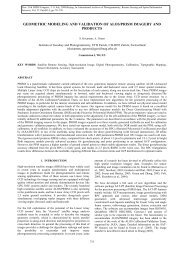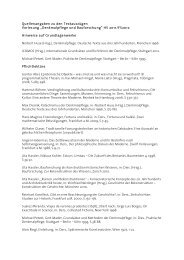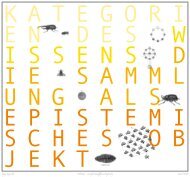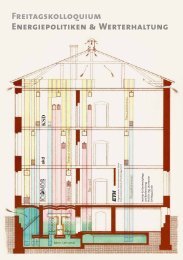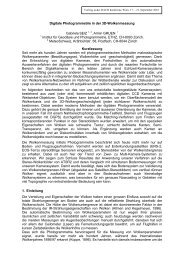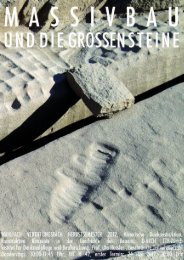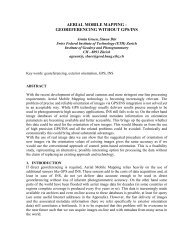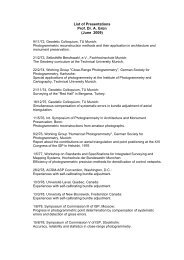Accuracy, reliability and statistics in close-range photogrammetry - IDB
Accuracy, reliability and statistics in close-range photogrammetry - IDB
Accuracy, reliability and statistics in close-range photogrammetry - IDB
You also want an ePaper? Increase the reach of your titles
YUMPU automatically turns print PDFs into web optimized ePapers that Google loves.
9U<br />
z NrHsNnH 0008-[<br />
TZ rss v8lss I luv<br />
Hlr Nnl r0 ^_Lrsur^lNfl lvJINHlrl<br />
^ l1l l,,ll,,lvu 90 -LoH d l0 8l VHJ<br />
NNUg NINUV<br />
^Ullhll^lvU9010Hd I9NVU-lS01l l.lI<br />
S]IlSIIV$ ONV ,\IIIISVII]U'A]ilN]]V<br />
rrdvd 0rrNrs 3 ud<br />
8t5r'lr- hr<br />
^ r l3l'l l..lv U 90I0 H d U0l<br />
lSn9nv.Nr0H)lors<br />
^rrr los rvNol rvN u3-tN I<br />
,^N0I SS I NhNJ<br />
h<strong>in</strong> r s0d l/l^ssstr9N0l-ur-LNI
-uä6 ! uo paspq aq ,{eul urtq,{ ({JpssaJau aq o1 stusäS sLapoul .li o uorlpz!pJppuplS p OS<br />
's!rpr6o.rd Jafnduol 6u!Xs txa<br />
Jo Ä?!trqpr!Ldde pup ,{1tL!qtlpdlltOr €q+ s;lnpaJ pup uo!snluol utplJoa p 01 sppäl<br />
srql sasParrur sLepoul lpa!1.puaq?€u j0 Jaqunu aq1 sulalqo,rd luaJaJlrp J.o Jaqutnu<br />
6urspoJau! up q1t/{ 1€q1 partlou,{LlpJaua6 s! 1! ÄJ1ällulp.t6o?oqd a6up.r-asotl Lll<br />
!ra Iq 0] aql p!E lueLllsn u!1P.rq!lP.-]tas Jo I apour I Pa !lpureqlPU öq.L '€<br />
'sualq0rd uor?pu_ !Jalap 1u!od u! 6urJpaddp uallo sasaqlod,{q 1sts1 o1 pe^rJ<br />
-3p ars sr.io!Ja1!Jc lsa? 0uros pup spoqleul tpt!1sl1p1s teraue6 01 apeu s! a_.uaJaJ.<br />
-aJ slLnse,r luaurlsnfpp sLpunq lo s!s{Lpup ä^r}ralqo ,ttep!/{ p rxJo}Jad of räpJo uI<br />
'paluäsaJd s !<br />
uo!1nq!Jls!p tuLod a6€urr g x g e rol las aLqelrns p pup papuäululoreJ sr. sL€rLlou<br />
-,{tod tpuoöoqtro €1s!Jp^!q I,o ldeluotr aql snql .1es JalaupJpd Lpuo!1!ppp eLq LxeLl<br />
pue Ip,]ö!a6 p saJr.nbar s,loJJa a6ei.ur lrlpualsfs Jo uo!+psuaduoa allsuöqaJduol<br />
V anbr.uqlel u o ! 1 p r q L I p r - J l € s iql .pn L.u r lsnui Iapoul a tpunq p a d o I e ^ a p ,f I q 6 L q V<br />
'seldrxpxa aLdutrs auos lo pLe äq1 q1!r,4<br />
,,ÄlrLrqp!LaJ,, pu! L'fapJnaapI sl]lr€l aql llo )iJpur ot radpd srql Jo €^!laafqo auo<br />
s! 1l tlp ]€ aLqe!taJ 6ur3q lnoqlr/,1 älprnJ!p 3q .(eu 1! Jo slrpd.lo uals,{s p 1eq1<br />
aa!10u o1, lupi.lodurr sr 1I<br />
.^1!rntes<br />
lprr?s!+p1s Lr!efr3r p q1!/,1 pelaö1ip aq upr<br />
azrs ur!1Jör p I,o sJoJrs sso,16 lt ,atqptlaJ!, palLpJ aq,{plr Llt3lsfs v .uo!l.aa1ep<br />
JOJJa SSOJ6 qt!A UO!1!euuol u! pasn f,tureu pup sJoJJa täpour,o ulaLqord €Ll1 rllllr<br />
palrauuor ,{l6uorls s! r!do1 s!q} /2,, ./Z/ fraaql, ^t!trq€!tar e,,prrrg uo past€<br />
'u0fluetlr ör0!r q1!^1 p.Lpnls aq ptnoqs suralsfs aqt lo Ä1r. 1!qp!teJ aq1 .ra^oaJol^l<br />
',{.rpssts!au<br />
,{lelnlosqp suo!lpnlrs luarpdsup./1-uou auos u! q6noql ,Jplndod,{re^ lou<br />
€rp rxol.sfs elpunq paltddp eqt uo sa!pnls ,{.p,tnr.p !Jo!Jd-p atdu!s ,{la^!1Blar ua^l<br />
',(Jlaulutp.r6oloqd<br />
u ! rlo r1us1tp<br />
ä.1or1r Pu!J pLnoqs fsapoa6 u! päsn ,{lu!pur sfpppaou (,'ip.1a '/9/ i?aq!) uorlptu!1<br />
-sa a.up!.1p^ !iorrelsod-! pue (./aa/ ?1?atlcg '/3/ puaaD.iLnt) uorlpuLurratep u6!sap<br />
)ro^11äu Jo saJnpeaord snoro6!J snql ,{lr lLqeL ta.r pue ,{)€rn)re q6!q lo aq o1 a^Bq<br />
sltnse.r eq1 lL ,{tLp!aadsa 'f.rleuiupJ6oloqd i6uP,r-tssolr u! luau3J!nbar !!9eq p sP<br />
paprp6eJ s! spoqlau padoLe^ap .{tq6rq 'LPJaua6 }o uo!1Pt!tddP pu€ uorlPa.r: i,q+ os<br />
'surpJ6oJd Jalnduoa u! qlL/'{ ),10r o1 luarua^uol erour rp.l, snql pup raILpüi aJp,{lLc<br />
-r€uab srrälsfs eul a.reur! ',{rlauup./60}oqd a6ueJ-asoLr Lr! €nr1 lou s! s!qx s€nb!u<br />
-qra? lpr!1s!1p1s pup Ip]rlp.LuaqlBul petp.!t.srqdos flq6!q lo uo!1€)rLdce aq] sele)<br />
-rLduor,{Llsoru suets,{s rpaurL e6reL }o 6urlpupq a!+ uo!tpLn6uplrl le}Jap u! aL!qr'1<br />
'loafoJd<br />
Lp!a€ds E jo suo!ldurnse.rd<br />
*-+j,<br />
"--,,p--0,10 uorlnt0s luaJejl!p ^upul 01 pal ;!q? 1sp0 tsq1<br />
uI sJoJJa r!?PLli1S^S pL.rP SuOrlnqrJlS!p LOJIUOr<br />
rSUO!1!pUOa UOr+rASralur rLrOLle]<br />
-uaLro ,1o!ralxa !uo!lEiua!Jo Jo!.ralLrr !trrleüoa6 r6PU! ol lradsäJ r.11!,{ suorlrpucr<br />
tua.raJl!p a?Lnb lo fl€!JP^ lPaJ6 aql u! sls!suo. u.ralqoJd ureu aqt uo!1eln6uPr.r1<br />
LP!rap uL punol suor.lrpuo: aql urorJ luafxa srx0s 01 rallrp qtrrqr{ sä,rn1?äJ: lpa<br />
-rd,{} fq pezrral)e.reqf eJe uoL+puruJalap 1u!od rol suel.s,{s a6upJ-asolr Lpl!lftpuV<br />
Lr0!+rnp0JluI<br />
^u1lr.ü,,rvä9010Hd lSNVr-is0t: NI s3ilsIlv.rs cNV Ä1t.tI€vI ]]d ,,lvunllv
-2<br />
eral <strong>and</strong> flexjble<br />
s e I f - € a 1 i b r a t i n g bundl e a dj u stmen t hav <strong>in</strong>g proved its efficjency<br />
<strong>in</strong> aerial trianS!lation. For the further analytical treatnent reference is made<br />
to the nodel of the exist<strong>in</strong>g bundle program 1,480P (14urich Bundle 0rientatjon with<br />
Addjtional Pararneters), orig<strong>in</strong>ally developed for aerial triansulätion problems:<br />
- eB = Aldx * A2dxP * A3dt + A4dz - lB ; P- r-tl<br />
i d,r P<br />
Idz-)za Pz<br />
(1)<br />
= Vectors of true errors of image coord<strong>in</strong>ates, additional parameters,<br />
control po<strong>in</strong>t coordi nates<br />
,dtrdr = Correction vectors of po<strong>in</strong>t coord<strong>in</strong>ates, control po<strong>in</strong>t coordrnates,<br />
elements of exterior orientation,<br />
additional Darameters<br />
= Vectors of observations of image coord<strong>in</strong>ates, additional parameters,<br />
control poi nt coordirates<br />
I<br />
= Identity natrix<br />
Collect<strong>in</strong>g the matrices <strong>and</strong> vectors of (1) <strong>in</strong> the follow<strong>in</strong>g manner<br />
(''<br />
42 A3<br />
00<br />
IO<br />
I<br />
0<br />
)<br />
0<br />
0<br />
:,i,)<br />
T<br />
1,n<br />
r ol<br />
(dx', dx , dt', d2 )<br />
oT rT rT<br />
(e-, e'' e' )<br />
(1) formally results <strong>in</strong><br />
,IT<br />
l,n<br />
<strong>and</strong> by us<strong>in</strong>g the operator<br />
varlances dn0 covarrances<br />
cvna.+er<strong>in</strong>n F :.1<br />
(2)<br />
rhe operatnr D wl^icf _eads to rhe<br />
AE(x) = E{l ) ,<br />
E(x) = !,x , E(l) = !t , E(e) = 0 ,<br />
(3)<br />
D{e) =."2p-1 , (o- = st<strong>and</strong>ard deviation of unit |reight<br />
to be estimated)<br />
Thereby the correction vect0rs of the grouid po<strong>in</strong>t coord<strong>in</strong>ates dx <strong>and</strong> of the<br />
elements of exterior orientation<br />
_Pdas<br />
ge'e"._ly to fjrea node's,<br />
dt are always <strong>in</strong>trodLrced as free !nknowns, what<br />
System (l) is called a 6ene.alized Gauß-Markov f4odel (,{o.l /12/). For known expected<br />
va_"es:, ard for P, = 0'r -1av be <strong>in</strong>terp"eted as (__\ed) qe9-essior<br />
'aL<br />
Model<br />
foy D_ I0. Frt, .0 ös ,-.)ed) coltocatjon l4ode_ (fr,"" ). I. !fe geod.t.c
-3<br />
cortrol po<strong>in</strong>t coor.i<strong>in</strong>ates are <strong>in</strong>trodu.ed as free of errors (diag (Pp) ' -),like<br />
it is often required <strong>in</strong> practice, ond if the additional parameters are treated as<br />
free unkno!']ns (PZ - 0), the ord<strong>in</strong>ary Gauß-l'4arkov j4odel , i.e. the Lrs!al cäse of<br />
Adjustment of 0bservdtions is obta<strong>in</strong>ed.<br />
The fiairix Pp allows to <strong>in</strong>troduce a-priori known accuracy st<strong>and</strong>ards of th€ control<br />
poirt "rrrd<strong>in</strong>atesi the same dpplies to the matrix PZ <strong>and</strong> the additlonal parameters.<br />
Us<strong>in</strong>g Pp = 0 the system becomes s<strong>in</strong>gular,<br />
Under certair<br />
circumstances <strong>and</strong> with certa<strong>in</strong> pärdmeter sets the treatment of systematic<br />
errers as free unkno\,Jrs tPZ = 0) may leöd to remarlable deteriorations of<br />
the condition of th€ system oi normal equations. Therefore it'is expedient to irtroduce<br />
PZ 10, thus protect<strong>in</strong>g to some extent aga<strong>in</strong>st overparanetrization.<br />
l{ith Ppl0lae obta<strong>in</strong> a vJeishted mji<strong>in</strong>ral fitt<strong>in</strong>g (with respect to a 3-dimensional<br />
s<strong>in</strong>rjlarity transfofmation) of the phötogramretric poirts onto the cortrol pojnts.<br />
l,Jith the set of adCitional paraLneteri from (1) yle are fully flexible, there is no<br />
restriction<br />
con€ern<strong>in</strong>g their nunber <strong>and</strong> type. This enables us to <strong>in</strong>troduce blockrnvarrant<br />
parameters, just as parameters vrhich belong to a s<strong>in</strong>gle strip,<br />
cer:a'. grouo of _mages o- Lv-ar to a s'r9le'nr!e.<br />
In <strong>close</strong>-ran9e appljcatior,s this concept has to be extended by observation equations<br />
for additional measurement elements as angles, dlstanc€s <strong>and</strong> exterior orjentaticn<br />
parameters <strong>and</strong> by some special conditions as straight I <strong>in</strong>e conditions,<br />
surface conditjons, af!1e conditions <strong>and</strong> so forth.<br />
leads to the conditior<br />
r -i<br />
Q (I r^) ++ v:. ,<br />
or if only the additional parameters are regarded<br />
to a<br />
For the purpose of the follow<strong>in</strong>g<br />
studies these equations can be omitted \1,ithout loss of generality.<br />
The same applies to other image geometries l/lhich may replace the perspective relations.<br />
For the determ<strong>in</strong>abilitJ, of syste<strong>in</strong>atic errors <strong>and</strong> the related eigenvector problenl<br />
see a!üt1 /1i /.<br />
'I he problefi of a s!itable<br />
choice of an additional parameter set vJas recently djscussed<br />
<strong>in</strong> c"ün iia/. Thereby the functional, numerical <strong>and</strong> statisticdl ddvartöges<br />
of bivariate orthogonal parameters,<strong>in</strong>troduced by Ebne! /€/,<br />
A sirategy <strong>in</strong> additional para,neter construction, i.e.<br />
matrix A4 (see (1)) must considef two basic requirementsi<br />
hare been emphasized.<br />
the choice of the design<br />
- The estifiation ot x <strong>and</strong> cf <strong>in</strong> 13) has to be unbiased, i.e. the systematic<br />
deformrtions have to be model ed as wel I as possi bl e<br />
- The variances of the additional parameters {<strong>and</strong> of the other parameters of<br />
systen (I))should be as sfiall as possible.<br />
To the fr'rst po<strong>in</strong>t -axper'r'ences, 9a<strong>in</strong>eC over nrany years! have sho\,/n that polynomiäls<br />
are a prop€r device ii Bodell<strong>in</strong>g systenütic ifiage errors. Thereby the favourab_r<br />
p-oDe-Ty J' oivar:are oo_y.ro,r'als co'sists ii its cBDabil'ty to comDe'sare<br />
rre roral sysre_atic effec- at al<br />
po<strong>in</strong>L, u- a p, esumeo "eg,lar imaqe Do<strong>in</strong>t scree<br />
lELneT /€/).<br />
The second requirenent, wfich <strong>in</strong>cludes equally the dem<strong>and</strong> for m<strong>in</strong>imal covariances,<br />
{4)
-4<br />
0-- = {A;P^4,) -M<strong>in</strong><br />
(s)<br />
As it is proved )n F.;. liE,/, the m<strong>in</strong>imun of 0.. is obta<strong>in</strong>ed l,lhen<br />
4..!,4.. r 0 :j t,...,i_I, i t,...,2<br />
z = nLrnber of add, parameters<br />
(6)<br />
i.e. for a diagonal vJeight matrix PB the opt<strong>in</strong>ral choice of A4 is obta<strong>in</strong>ed, if the<br />
columns of A, are orihogoral, not necessarily orthonormal . (Nence orthogoral ity i s<br />
def<strong>in</strong>ed as : A'PA = D, D= diagonal matrix).<br />
Although the concept of orthosonality is strongly valid only <strong>in</strong> the case of extremely<br />
regular network ar<strong>range</strong>ments, orthogonal sets provide <strong>in</strong> practice for the<br />
hc (i n.(
o"@<br />
-Fb--+<br />
Fi gure ir Regul ar irnage po<strong>in</strong>t screens<br />
@...<br />
o...<br />
3x3 di stribution<br />
5x5 di stribution<br />
For vertical photography <strong>and</strong> flät object this set i s outl ifed to be even <strong>in</strong>dependent<br />
on the exterior orientation elements, lJnder very general conditions (large<br />
rotdtion e'lements, space character of the object) the correspond<strong>in</strong>g sets can be<br />
eltended by some of the 6 coefficierts<br />
which are highly correlat<strong>in</strong>g with th€<br />
6 exterior orientation elements <strong>in</strong> the case of vertica'l photography <strong>and</strong> ilat obip.r<br />
-1 1-t>-. ' -1r lF.. sFr /hp-6 rhF o,-a-eTe-q of <strong>in</strong>rerior orierTdtion<br />
are also <strong>in</strong>cl!ded). l,lith the creation of the complete set one has to pay<br />
Ettentron to the sequence of the rotation elements. For exampl€, if r is chosen<br />
dependert on ( <strong>and</strong> o ther one of the two ljnear terms |,{hich lead to image torsjons<br />
has to b€ rejected a-prr'ori.<br />
Eecause of th€ possibly high correlations the extended sets have to be tspplied<br />
very carefully. To protect a!a<strong>in</strong>st overparametrj2ation, j.e. to avoid the <strong>in</strong>troduction<br />
of remarkable <strong>in</strong>stabilities <strong>in</strong>to the l<strong>in</strong>ear systefi (l) sophisticated statistica'l<br />
test methods nust be used for ädditional paraneter sjgnificanc€ test<strong>in</strong>g<br />
ir any case (see G?üa /1t/, /ii,/ <strong>and</strong> also sectior Dl of this paper).0ne has to<br />
note thät the 1-d<strong>in</strong>ensional Student test leads to vrrong concl usions concern<strong>in</strong>g<br />
t.e €(Leptdlc€ o- yelect'or o' irai"'d"dl<br />
roo'Ttoral Dora-elP"s 'f dBngero's corYelations<br />
do occur, Thus a more comprehensive treatment of statistical<br />
hypotheses<br />
C. <strong>Accuracy</strong> <strong>and</strong> rel iabil ity of <strong>close</strong>-<strong>range</strong> bundle systems<br />
Nitherto <strong>in</strong> photogranmetric <strong>close</strong>-ran9e systems the accuracy was almost exclusi!el<br />
jn the center of <strong>in</strong>terest. In ttris conneciion sometim,.s d lot of |./ork was <strong>in</strong>vested<br />
to derive "accuracy predictora" v/hich should represent a k'ird of accuracy models<br />
for special, often appear<strong>in</strong>g net\,,ork arrargements. Nevertheless, among all accuracy<br />
predictors the <strong>in</strong>verse of the nornal equatiors of a bundle system is still<br />
the best one, It acconmodates €very chang<strong>in</strong>g netl,vork configuration <strong>and</strong> evefy model<br />
väriation. So the design of a proiect should be conneci:ed with the deterfi<strong>in</strong>ation<br />
of the correspond<strong>in</strong>g <strong>in</strong>ve.se for sophisticated accuracy studies. This becones important<br />
more than ever, s<strong>in</strong>ce the <strong>in</strong>troduction of additioral parameter sets complicates<br />
an empirical accuracy appraisal, Besides the acc!racy of a systen its<br />
<strong>reliability</strong><br />
should become a mair objective of future studies.<br />
The <strong>reliability</strong> of a model descr'ibes its sensitiveness with respect to model<br />
errors. If a highly developed s e I f - c a I i b r a t i n I bund le model js used \,ve maJ restrict<br />
our considerations on the problen of gross errors.
-6<br />
5o b, je'ni o1 tle'€r- "-e'do'.i'y' sho" d oesc/toe rhe syste- s q,al'ties<br />
for gro ss error detecti on.<br />
It was laa?ja /2/, /3/ wha developed a rather complete <strong>reliability</strong> theory. Nis<br />
dpproach enables the treatment of the gross error detection problem on a statistical<br />
basis. tidrdr's theory maJ equally be applied to theoretical <strong>reliability</strong><br />
s Ld'es o' b,ndle ad'-srne.T sys:e-s as to rre derecr or or grass erro-s ' O.aLtical<br />
projects. ior detaill€d <strong>in</strong>formation abaLrt the whole theory see ,/2/, /3/, 1tl<br />
the follow<strong>in</strong>g only a short extract is presented, €s far as it is necessary to<br />
-.de-sLard t'e p-"cL'cd corp.rd'ior c pyererred i-r tfls paper.<br />
Start<strong>in</strong>g fron system (1) with the statistical<br />
2<br />
-e=Ax-l ; P<br />
D(e) = D(r) = oo2p-1 Ete) = 0<br />
t -l r<br />
(A'PA) A Pl = qlxA Pl<br />
nodel<br />
variance unbiased est<strong>in</strong>ators for x <strong>and</strong><br />
(8)<br />
reounaancY r = n-uJ<br />
I tol-t ttoror-, t = $r<br />
<strong>and</strong> for th€ residual s we obta<strong>in</strong><br />
<strong>and</strong> with<br />
v-A,-l -- 1-A0\^!'P\l<br />
(10)<br />
vle get<br />
Quu = P-1-AQrrAT<br />
v = - QvvPl<br />
(11)<br />
(\2)<br />
Regard<strong>in</strong>g nrodel (8)<br />
the test criterion<br />
o2, th"n if Ho is true<br />
as null-hypothesis Ho with E(i02 /Ho) = (13)<br />
is distributed as the central F-djstrib!tion F(r,*). Thus e is used as a global<br />
test criteriorn tottest<br />
I (l ! N(Ax,c.'P -)).<br />
the presum€d multi-d<strong>in</strong>ensional normal distribLrtion of<br />
1f Hc isreiectedone has to set up one or more alternative hypotheses HA.<br />
S<strong>in</strong>ce the systemat'ic errors are widely compensated by our self-calibrat<strong>in</strong>g model<br />
v/e may conf<strong>in</strong>e oLrrselves on the <strong>in</strong>vestigation of gross errors. Then a set of p<br />
€_re"raT ve hyoorl^eses rA_ car be "o--ulated as<br />
P = 1,..,P alternative<br />
tOO, o,O = oo.O.O nyp0rneses<br />
(14)<br />
c" = vector represent<strong>in</strong>g the<br />
r proportions of the<br />
gr0ss err0rs<br />
If HAh is accepted, then o is distributed<br />
F(r,-:lp)<br />
l,9ith the noncentral jty parameter ip.<br />
p<br />
as the foncentral F-distribution
-7<br />
HA^ I eads to<br />
'<br />
tl;:/AA'J = Eta:/H") - "".2p<br />
(15a)<br />
,"2 = !-L"2<br />
(15b)<br />
).p depends on the type I error size d, on the type II error size F(),p)<br />
(E(rp) = 1-P(II), P(II) = probability of accept<strong>in</strong>s<br />
degrees of freedom r, -. For a given d,ß(ip), r we can f<strong>in</strong>d rp by usirg lcc?Ca,s<br />
nomograms <strong>in</strong> /3/, pp. 2I-23.<br />
If NAp is true, ther the estimators i a,rd i"2 are no mor€ unbiased. If the effect<br />
of a gross erroT vector nlp <strong>in</strong> the observations upon the residual vector v has to<br />
be computed then we obta<strong>in</strong><br />
A'lthough <strong>in</strong> practical<br />
E(v/HAp ) = l(v/H<br />
vvo = - Quu P rl p<br />
projects we normally don't kfot anythirg about the vector<br />
cp - it <strong>in</strong>dicates the relationship of the gross errors - eq!ation {17) enables<br />
us to study the effect of an a-priori supposed qross error vector nlp upon th€<br />
residual vector v. From (14), (15), (17) <strong>and</strong> from the idernpotency of the natrix<br />
product QvvP it follows for small gross errors<br />
(16)<br />
(17)<br />
rO . Noro2<br />
no = cf rouurc o<br />
(18)<br />
The vector !l<br />
p conta<strong>in</strong>s all<br />
orl y one gross<br />
error <strong>in</strong> the<br />
pt h al ternati ve hypothesi<br />
we ge!<br />
HA1:<br />
rlg(r) = o-.tot<br />
(re)<br />
<strong>and</strong> l4i th<br />
T<br />
(0,<br />
.0,1,0,.,.,0)<br />
t1A1 :<br />
!t 1(i<br />
) -<br />
(20)<br />
comb<strong>in</strong>irg (18) <strong>and</strong> (20) we<br />
r,e. !11\'/<br />
tl^.,<br />
rl'{i)=<br />
r1<br />
rs the m<strong>in</strong>imal gross error !./hich car be det€cted wr'th the probaility<br />
B(r1). Thus for a constant rt for all possible i !11(i) represents a suitable <strong>in</strong>dividual<br />
<strong>reliability</strong> <strong>in</strong>dicator ("fieasure for <strong>in</strong>ternal reliabjlity" <strong>in</strong> 8dcüa /3/)<br />
Furthermore, taa!ia /3/ has developed a t€st criterion for test<strong>in</strong>g the residuals<br />
of an adjustment (" d a t a - s n o o p i n g ' ) . If Ho is rejected, we get<br />
_.I<br />
",,<br />
t' n<br />
- =-:-.- 2? )<br />
!iith one of the possible alternative hypotheses (c1,..., cp) = I from (14) <strong>and</strong> by<br />
us<strong>in</strong>g a weight matrix of diagonal forri \{€ obta<strong>in</strong><br />
for diagonal P:<br />
' N1 = Pi2 qvivi ' Gr)<br />
Qvivj = i!r diagoral<br />
el ement of Qvv
-8<br />
*1 --i-<br />
-o \qvivi<br />
t,z3 )<br />
The acceptance i nterval for wr i s then<br />
- ril, 1r -.", r,-1.,r.. r'/, t,t -'.,t,*)<br />
\24 )<br />
\Jhere oo is the type I error si:e for the test cr'r'terjon wi.<br />
'Tevel<br />
Tire significance oo for th€ test of <strong>in</strong>dividual residLräls (23) is dependent<br />
on the significanc€ l€ve1 d of the global test (13). ;acrda harßronizes o l'vith sö<br />
by putt<strong>in</strong>g t(r-) = p()r), i.e. by us<strong>in</strong>g equal type II error sizes for the global<br />
test <strong>and</strong> the <strong>in</strong>dividual iest. For the relations between d <strong>and</strong> öc see the nomogranrs<br />
itt /3/, pp. 2I-23. As far as the author could !nderst<strong>and</strong> thi s, the harmoniz<strong>in</strong>g<br />
between o <strong>and</strong> o<br />
was based on the assumption that the s<strong>in</strong>gle pvents wi are <strong>in</strong>dependent<br />
on each otirer. Nence a most<br />
rel iable system is required for ar effective<br />
applicatior<br />
of the data-snoop<strong>in</strong>g techniquei otherwise the danger of false<br />
<strong>in</strong>ference is too great. At least we have to exclude those observations from the<br />
test procedure - or better: lre have to change the network arrargement <strong>in</strong> a ray<br />
that those observations don't occLrr - vlhich are correlat<strong>in</strong>g too much |lith others,<br />
This is valid especially for "spur' observations, i.e.<br />
for observations which<br />
lead to o,, = 0 (zero variance problem), sr'nce <strong>in</strong> the extrefie case of spur observations<br />
the test criterion lar= 9 is not def<strong>in</strong>ed.<br />
lil 'vras<br />
Irl (21) tlj<br />
denoted as an <strong>in</strong>dividual <strong>reliability</strong> <strong>in</strong>dicator. The amount for<br />
rne compurdrron or dr rnoivraual N1= Plevivi (if P is diagonal <strong>and</strong> if only one<br />
gross error is assumed) may sometimes prevent of <strong>in</strong>dividual conpLrtations. However<br />
r/e are able to make some statements on the global <strong>reliability</strong><br />
of a system (see<br />
Fi)rstne! /71, '.!rr /1i/, Pope ,/17/).<br />
1n Gvür /11/ the average diagonal term of Qvv was proposed to serve as g'lobal<br />
rel iabil ity <strong>in</strong>dicatori<br />
tr10 )<br />
Rl 1 = ---!l{ =; .-5"<br />
nr1,';= 2tI(qiu) ,<br />
tr"raJ<br />
xtty J = ---r<br />
t<br />
(25b)<br />
r = redundancy, n<br />
= number of observations<br />
0f course global <strong>reliability</strong><br />
<strong>in</strong>dicators can be constructed whjch do more refer to<br />
the "exterral" r€liability (Ba. e /3/), that means to the effect of gross e.rors<br />
upon the f<strong>in</strong>al<br />
prod!ct of the ddjustnent - th€ obiect po<strong>in</strong>t coordifates. Those<br />
would correspond even more with the follovJ<strong>in</strong>! accuracy <strong>in</strong>djcators.<br />
But here th€<br />
term "reliabjlity' should be stronger connected with the detection ihän with the<br />
effect of gro ss errors.<br />
rr o1d,o9ou- 9i0od. o.(u'd.) rc_cat0r ,orra u" t'.ll'*), yet we Lrse the average<br />
st<strong>and</strong>ard deviations of the po<strong>in</strong>t coord<strong>in</strong>ates (l,vith co = 1):<br />
Ar (T) =<br />
Ar(x) =<br />
tr (<br />
! k: number of po<strong>in</strong>ts, <strong>in</strong>clud<strong>in</strong>g (26a)<br />
the control poi nts
Ar(Y) =<br />
,.('\fd; )<br />
--- t26b)<br />
Ar \7)<br />
In the follo!'l<strong>in</strong>g a s<strong>in</strong>rple practical e,ample is <strong>in</strong>troducted to clarify the above<br />
mentioned problens <strong>and</strong> to show the practicdl potential of the datö-snoop<strong>in</strong>g<br />
techniq!e.<br />
Although <strong>in</strong> C?ü, /ii/ tdee's approach of the gross<br />
emofasized, n 1l's paDe.:-.:: s opp.odcr 's ucea because the values of the<br />
Tau - distributiort lP.pe /i?/) are not available for the author by no\1,.<br />
Another <strong>in</strong>terest<strong>in</strong>g method was praposed hy Eer-r';Lg/4./ whjch shoul d al so recei ve<br />
future atterti or.<br />
for '-rITe. de-o sr.a-io' rhe p"36a',u, e,d"ple o'<br />
on synthetic data.<br />
z=ro-r<br />
z= 5+<br />
.//,/<br />
4... control po<strong>in</strong>ts<br />
o... po<strong>in</strong>ts to b€ determ<strong>in</strong>ed (ne\,v pojnts)<br />
a.,, camefa stations<br />
Figure 2: Net!'lork ar<strong>range</strong>ment for the denonstration<br />
of acc!racy <strong>and</strong> r€'l iability problems<br />
lle suppose a cube which conta<strong>in</strong>s 27 regularly distributed po<strong>in</strong>ts;8 of them serve<br />
-'le<br />
as corrro- pcirts. The orrers aye nek po"Is. camerä sta!ions a'€ de'loled by<br />
nos. 0, ...,8.<br />
Table l shows the orientatior elements of the <strong>in</strong>dividLral <strong>in</strong>ages.
10<br />
Table 1:<br />
0rientati on el ementsof the images of the netl,Jork ar<strong>range</strong>ment of<br />
Figure 2<br />
Images<br />
0<br />
I<br />
2<br />
3<br />
4<br />
5<br />
6<br />
7<br />
8<br />
c<br />
["] [']<br />
100<br />
100<br />
100<br />
100<br />
i00<br />
100<br />
100<br />
100<br />
100<br />
0<br />
-1<br />
l<br />
5<br />
0<br />
0<br />
0<br />
0<br />
.Yr<br />
LfiI<br />
0<br />
0<br />
0<br />
0<br />
0<br />
0<br />
0<br />
0<br />
0<br />
z.<br />
['] tir ral<br />
a<br />
5<br />
5<br />
5<br />
5<br />
4<br />
6<br />
0<br />
10<br />
0<br />
0<br />
0<br />
0<br />
0<br />
0<br />
0<br />
0<br />
0<br />
0<br />
0<br />
0<br />
-24.483<br />
20.483<br />
0<br />
0<br />
0<br />
0<br />
0<br />
0<br />
0<br />
0<br />
0<br />
0<br />
0<br />
20.483<br />
-24 .483<br />
l,Jhile the object poirts <strong>and</strong> the control distribution<br />
rena<strong>in</strong>s unchanged <strong>in</strong> the<br />
fol lol,<strong>in</strong>g computational versions, the images are grouped as seen froßr Table 2,<br />
For simpl ification al I versions are conrpLrted ur'thout additional paralrreters <strong>and</strong><br />
with fixed control po<strong>in</strong>ts (diaS (Pp) + -).<br />
Table 2: Inrage ar<strong>range</strong>ments <strong>and</strong> global accuracy <strong>and</strong> <strong>reliability</strong><br />
irdicators<br />
AI(X), AI(Y), AI{z), AI(T), RI(x'), RI(y'), RI(T);.o = t um<br />
I<br />
c<br />
D<br />
E<br />
l-2 t08<br />
3-4 108<br />
3-0-4<br />
1-2-5-6 216<br />
3-4-7 -8 2r6<br />
69<br />
69<br />
75<br />
81<br />
8i<br />
39<br />
39<br />
81<br />
AI(X)<br />
t"t<br />
4.21<br />
0.09<br />
0.08<br />
0.18<br />
0 .07<br />
AI(Y)<br />
[.*]<br />
t.r7<br />
0.29<br />
0.28<br />
a .92<br />
0. 21<br />
i cato<br />
AI(Z)<br />
["]<br />
a .27<br />
0.11<br />
0.10<br />
0.18<br />
0 .07<br />
s<br />
Relia<br />
AI lT]<br />
LnrmJ<br />
RI(x'<br />
0. 57 0.19<br />
0.16 0.20<br />
0.15 0.43<br />
0 .43 0 .62<br />
0.1? 4.62<br />
ility<br />
RI(Y'<br />
0.s3<br />
0.52<br />
0 .64<br />
a .62<br />
a .62<br />
<strong>in</strong>dic<br />
Rr(r)<br />
0.36<br />
0.36<br />
0.54<br />
0.62<br />
0 .62<br />
number of observations<br />
number of u n knov/n s<br />
r -u = redundancy<br />
R I(T) Figure 3:<br />
i.." ri. v ih/li.:t^hc.f tha<br />
n/:.t1.nl a$mnl !( .f T:hlp
11<br />
Table 2 together llith Fjgure I show the global <strong>reliability</strong><br />
Some <strong>in</strong>terest<strong>in</strong>g conclLrsions can be drawn from these <strong>in</strong>v€stigations,<br />
Compar<strong>in</strong>g<br />
the Slobal irdicators<br />
änd acc!racy <strong>in</strong>dicators.<br />
RI(l) <strong>and</strong> AI(T) of the <strong>in</strong>dividual network versions<br />
l,le notice t höt good accuracy doesr t correspond necessarily with good rel iabil ity.<br />
Though version B provides for fairly Sood accuracy, the reliabilitJ is poor. This<br />
refers ma<strong>in</strong>ly to the <strong>reliability</strong> of the r'-coord<strong>in</strong>ate observations. Here we have<br />
to state that if only two images ar€ available (see al so versior A) a gross error<br />
of those <strong>in</strong>age coord<strong>in</strong>ates lvhich belong to the epipolar plane cannot be detected<br />
at all (zero variance problem - 'sp!r' observations).<br />
0f course this is not trLre for control po<strong>in</strong>ts, so that RI(x )of version A, which<br />
Tfe ) _-es.dua-s (w'Ti o .I:r) ts ro! eo_a_<br />
to zero. Though the x'-coordjnates of version B don't belons exactly to the epipolar<br />
plane (d,=-{,. = 20.4819J, their <strong>reliability</strong> is still poor (that yields for<br />
the non-cortrol po<strong>in</strong>ts), 0n the contrary the <strong>reliability</strong><br />
of the y'-cöord<strong>in</strong>ates of<br />
versions A,B is s!fficient (A:RI(y') = 0.53,8;RI(y')= 0.52), i.e. a gross error<br />
ir those y'-coord<strong>in</strong>ates has a good chal1ce to be detected (see the subsequert<br />
exanples of data - snoop<strong>in</strong>g); bLrt here another problem reve!ls:<br />
gross el.ror local ization.<br />
the problem of<br />
E.ianrple C (l images) provides for better reliabjlitJ, especially <strong>in</strong> the x'-coordr'-<br />
rEtes (ql('') - 0.41). Ir rFis case we dre .b p Lo deiect ä gross e-ro" ever 'r<br />
the x'-coord<strong>in</strong>ates of non-contrcl po<strong>in</strong>ts.<br />
Theexanples D <strong>and</strong> E sho!J an equally good <strong>reliability</strong><br />
behaviour <strong>in</strong> x'- <strong>and</strong> y - coord<strong>in</strong>ates,<br />
what is due to the symmetric network arrängement, |,/hile the accuracy<br />
of \ersron L r s fEr more berter<br />
Summariz<strong>in</strong>g the experiences ga<strong>in</strong>ed by these <strong>in</strong>vestigations <strong>and</strong> <strong>in</strong>dicated by the<br />
applied accuräcy önd relidbrlity <strong>in</strong>dicators \'e have to prefer def<strong>in</strong>itely the<br />
arranSement E (images 3-4-7-8), because only ir this case the x'- <strong>and</strong> yr- observations<br />
are of sufficient<br />
object poi nts.<br />
lvoreover. tlese<br />
cLrrdcy <strong>and</strong> <strong>reliability</strong><br />
reliabil ity together !,,r-th a satisfactory öccuracy of the<br />
ir /es+iSa'_ons mdy s ou !!e necess_Ty of oe"ormirg d-Dr o_: a(-<br />
studies for a proposed proiect, This becomes the more nec-<br />
:'F1 rrn-ir:'t ( "'P Ar a rLle ofe<br />
should aspire reliabil ity <strong>in</strong>dicators whjch ar€ at least equal or even greater tlran<br />
0.6 (RI(x') :0.6, RI(y') :0.6) - <strong>in</strong> accordanc€ with the values Sa<strong>in</strong>ed by the <strong>in</strong>vestigation<br />
of aerial triangulation systems (trrr /ill) .<br />
Natural'ly the global <strong>in</strong>dicators don't provide <strong>in</strong> each practical case for sufficiert<br />
accuracy / relr'abiljty of all <strong>in</strong>dividual object po<strong>in</strong>ts / observations, e.9. if<br />
sofie observations have to be cancelled or if po<strong>in</strong>ts cannot be observed from certa<strong>in</strong><br />
camera statiors,<br />
whatever the reasor may be for that. So the global <strong>in</strong>vestisation<br />
has often to be replaced by an <strong>in</strong>dividual check<strong>in</strong>g (see (21)). fo get further<br />
<strong>in</strong>sight<br />
<strong>in</strong> detail problems <strong>and</strong> to become famil iar with the data-snoop<strong>in</strong>g technique<br />
the arrang€nrents of Fjgure 2 <strong>and</strong> Table 2 will be subject to the data-snoop<strong>in</strong>g<br />
procedure, To leep as <strong>close</strong> äs possible !o practic€ the synthetic imaSe coord<strong>in</strong>ate<br />
observations of al I vers'ions are super<strong>in</strong>rposed by a r<strong>and</strong>om generator l'itil neans<br />
.0 ard s.arddrd devtariors , - ..,.<br />
r t--1.<br />
Then <strong>in</strong> all versiors A - E different gross errors are irtroduced as {the gr0ss
12<br />
errors do exclusively appear at images no, l resp.<br />
3 <strong>and</strong> at po<strong>in</strong>ts no. 1 resp. 2)l<br />
Ca se a<br />
0ne gross error at the jmage coord<strong>in</strong>ate<br />
of <strong>in</strong>rage 1 resp. 3: rxi = - 30 lnr<br />
of control po<strong>in</strong>t no. L<br />
Ca se b<br />
Ca se c<br />
Ca se d<br />
Two gross errors sim!ltaneously at the image coord<strong>in</strong>ates x', y of<br />
of <strong>in</strong>age I resp. 3r ryf = - 30 unr<br />
control po<strong>in</strong>t no.1 of image 1resp.3: txi =ryi = -30unr<br />
j.>-o<br />
.l, adtnaIe l' of non-control po<strong>in</strong>t no.2<br />
of image 1resp. 3: txi = - 30 unr<br />
0ne gross error dt the image coordjnatey' of non-control po<strong>in</strong>t no.2<br />
Lirl -espect to case o tre act as i or_\ one c/oss e-ro. e)jsrs, d Lho,gr Lwo<br />
ir!r1:<br />
-ad.<br />
no = 0 '001 {0,Ii)<br />
E(ip) = E(),1) = Bo = 0,8 (801;)<br />
io = lz.r ,\n-= 4.14<br />
Critical<br />
value for data-snoop<strong>in</strong>g (with o<br />
Hence the m<strong>in</strong>imal gross error \4hich can<br />
lwith P- = I)l<br />
",1i)_ li==<br />
" \'vivi<br />
= 0.00I) from -n-q -): c{w.)= j.29.<br />
rF'o"e- Llrh 'rF -v.hrfili-r js<br />
(27 )<br />
val ues<br />
obta<strong>in</strong> for the different ar<strong>range</strong>menls an0<br />
of Table 3 for the n<strong>in</strong>imal gr0ss err0rs.<br />
Table 3<br />
:[l<strong>in</strong>imal<br />
gross errors to<br />
be detected wi th<br />
the Drobabil itv B = 0,8.<br />
Ar<strong>range</strong>men!s<br />
rxi(m<strong>in</strong>)<br />
Ir']<br />
Ca<br />
txi('n<strong>in</strong>)<br />
Iu']<br />
eb<br />
L!t<br />
[a se c<br />
rxi(nr<strong>in</strong>)<br />
[u']<br />
Ca se d<br />
!y2(m<strong>in</strong>)<br />
lu'l<br />
B<br />
c<br />
D<br />
E<br />
28 .3<br />
29.6<br />
25 .5<br />
27 .2<br />
28 ,3<br />
3r .4<br />
29.6<br />
25.5<br />
27.2<br />
27 .2<br />
29.6<br />
27 .7<br />
25.2<br />
26.8<br />
48.5<br />
3?.4<br />
31.3<br />
32.0<br />
32.4<br />
27 .3<br />
26 .2<br />
From Tabl e 3 Vle see that the m<strong>in</strong>imal gross errors are grouped around 30.m,<br />
the cases Ac, Bc, Cc. That's th€ reason l'hy !i.e have <strong>in</strong>troduced for all<br />
cance I evel oo for data-snoop<strong>in</strong>g was kept corstantly,<br />
excePt<br />
cases a-d<br />
a gross error of -30 !m,<br />
After the conp!tatjon of all error cases wjth all netlaork ar<strong>range</strong>ments we have got<br />
rne.esLlrs o{ tao'e + -o- .1e s oDo- Les LFo: E'61. =,1, Rar: L (a +h.
13<br />
the global test - taken from tccnc'a,s<br />
tit 0.45.<br />
nom0granr s 1n /';/ - is vary<strong>in</strong>9<br />
f ron A .22 rn-<br />
Table 4: Global test of the null<br />
ar<strong>range</strong>nents <strong>and</strong> gros s<br />
-hypot hesi s N!:<br />
E(t2) = c2 for atI<br />
Ar<strong>range</strong>-<br />
A<br />
B<br />
c<br />
D<br />
E<br />
6 for gross error<br />
2.06<br />
4.92<br />
"i.]c<br />
1.30<br />
0.85<br />
2 .51<br />
1.07<br />
1.38<br />
i.58<br />
0.98<br />
r.40<br />
0. 57<br />
1.13<br />
1.28<br />
0.83<br />
1.75<br />
0. 99<br />
7 .23<br />
L 34<br />
0.94<br />
c(e)<br />
1.18<br />
1.18<br />
1 .02<br />
l.a2<br />
a .22<br />
0 .22<br />
0. 37<br />
0.45<br />
gross ef r<br />
1.40<br />
0. 57<br />
0. 96<br />
L,2L<br />
o.72<br />
. i3<br />
a6<br />
c(€) fron F (1-a,r,-)<br />
Regard<strong>in</strong>g the results of Table 4 r€asonab'l e doubt is p!t föruärd with respect to<br />
the practical application of the -olobal test.<br />
In the gross error cases both versions<br />
I <strong>and</strong> E don t lead to the correct statenent, i.e. to the rejection of the<br />
n u I 1 - h y p o t h e s i s , Though there are fairly good p re s Lrmpt i on s, bec au se the expecta -<br />
ti0n E(i;) = c: is a-Ffi0ri fiown by the utilization of a r<strong>and</strong>om generator even<br />
under the null-hyfothesis {|,{hen no gross errors are iicluded) the critical vä'lues<br />
are exceeded tvJice. 0f course the r<strong>and</strong>om generator produced di screte r<strong>and</strong>om<br />
val ues, whose st<strong>and</strong>ard deviat'ion differs fiore ore I ess fron the a-priori choser<br />
value of 5 rfi, bLrt this probl€m is ever <strong>in</strong>tersified <strong>in</strong> real practrcal projects:<br />
llhat is ther the expectation of ä2? ThEt is probably the reason why ?ape /1?/<br />
doesn t use the global test - generally its pot,er of assertion is not sLrfficient,<br />
Nence it is not reconmended <strong>in</strong> practjce to make the setup of <strong>in</strong>dividual tests<br />
( d a t a - s n o o p i n ,o) dependent on the resul t of the 9l obal test. The procedure of datasloot''g<br />
'lould te applied ir an) case i' -easo'rab'e srsp'c_o e,jsls Ltso g_oss<br />
errors may appear, v/hat is the st<strong>and</strong>ard situdtior<br />
In this way vre cont<strong>in</strong>!e \{ith the irdividual<br />
at least partly the disturb<strong>in</strong>g effects of correlations<br />
VJ<br />
l4i=-tsmaxrmat.<br />
"vi<br />
As a result it l4as found out that alI a-priori<br />
knovrn gross errors have been detected,<br />
€xpect <strong>in</strong> the follo\4<strong>in</strong>g cases;<br />
<strong>in</strong> prdctical projects.<br />
check<strong>in</strong>g of the residLrals. To avoid<br />
bet\'een the residuals the<br />
those observations, for \,rhich the test criterion<br />
1, Gross error case c <strong>in</strong> ar<strong>range</strong>ment A <strong>and</strong> B: zero variance situation<br />
2, Failure vJith the gross error case a of ar<strong>range</strong>ment 8:<br />
the xr-observation of po<strong>in</strong>t no. 3 at image 3led<br />
thus to the prior r€jection,<br />
to flrax (\{i) <strong>and</strong><br />
although not jnclud<strong>in</strong>g a gross error<br />
3. Failur€ with the gross error case b of ar<strong>range</strong>mert B:<br />
the xr-observatr'on of po<strong>in</strong>t no. 9 at image 3led to max (\,ri),<br />
although not <strong>in</strong>cludjng a gross error
- 1.4<br />
4. Failure \,Jith the gross error case c of ar<strong>range</strong>ment D,<br />
v,here the test criterjon wi = 3,15 of the x -observation of<br />
po<strong>in</strong>t no.2 at <strong>in</strong>rage l rema<strong>in</strong>ed slightty urder the crjtical<br />
value of c(1,.lj) = 3.29<br />
Analys<strong>in</strong>g these fail!res it becones evident that <strong>in</strong> 1. there is a-prjori no<br />
chance for detection at all (zero variance problem). In 4. the situation |ias net,<br />
l,]here th€ actual gross error (30um) is s'naller than the n<strong>in</strong>imal gnoss error \ahich<br />
can be detected wr'th the Frobability Eo = 0,8 (see Table 4). Sett<strong>in</strong>g rxi = - 32.4fßr<br />
<strong>in</strong> version D the correspond<strong>in</strong>g test criterion exceeds the critical value, thus<br />
lead<strong>in</strong>g to a correct rejectjon.<br />
The false r€iection of x! at image 3 jn case Ba afd of xb at <strong>in</strong>aSe 3 ir case 8b<br />
is probably a r€sult of shift<strong>in</strong>gs caused by correlations. Actuatty the preserce<br />
of correlations distLrrbs significantl] the statisttcal foundation of the gross<br />
error problernr so that correlations<br />
should be subject to future studies, The<br />
correlations becone particularly of <strong>in</strong>terest <strong>in</strong> a doLrble sense:<br />
- For the rejection procedLrre of data-snoop<strong>in</strong>g. The ans\1,er to the question<br />
vJhether orly max (\1i) or all \,i v/hich exceed the critical value should<br />
be rejected depends on the size of correlations.<br />
- For the locali?ation of gross errors the correlatr'ons are of decisive<br />
jmportance. Consr'der our practical e{amples: ln the cases Ad, Bd the<br />
localization of vyi is impossible s<strong>in</strong>ce the residLrals vyi (image i)<br />
<strong>and</strong> vyä (ima!e 2) resp. vy, (image 3) <strong>and</strong> vy, (imaSe 4) are perfect'ly<br />
correlat<strong>in</strong>g,<br />
x'-residuals<br />
Stronq correlätions exist also lr case Cc bet!/een !ne<br />
of a non-control po<strong>in</strong>t jn all three jmages, Here |,/e obta<strong>in</strong><br />
for the correlation coefficr'ents of the xr-residuals of po<strong>in</strong>t no.2:<br />
rv1 f:lvr, fOl=<br />
- 0.960 , rvx , l3l vx , l+l<br />
= o. sso , ru" ' lol vy' l4l = - 0.960<br />
(ifirage nunber <strong>in</strong> brackets)<br />
with the result that the gross error rxä cannot be locdlized.<br />
Experien.es ga<strong>in</strong>ed so far Nith the data-snoop<strong>in</strong>g technique are very enrourag<strong>in</strong>g,<br />
expecially if its results äre compared vrith corventional , non-statistical<br />
of gross error detection.<br />
methods<br />
Fron all 23 gross error cases of our examples (the 2 zero variance cases are excluded)<br />
\,ve obtaired by corventional methods <strong>and</strong> by data-snoop<strong>in</strong>g:<br />
So it becomes ar ir"jportant <strong>and</strong> promi s<strong>in</strong>g task to do further <strong>in</strong>vestjgatiofs <strong>in</strong><br />
_are_r<br />
th's "eld o'"esea"ch ro a"-ive<br />
ör slsre':s for po<strong>in</strong>t determiration pro-<br />
!_dj.9 to. both öccurac) <strong>and</strong> -e_ iat'_'T\.<br />
lvi> 3c.: 15<br />
lvl,3ä": t0<br />
t9<br />
da!a-sn0oprng: .^hrar + roia.tr.n<<br />
T2<br />
i ncorrect re jet ions<br />
<strong>in</strong>cofrect rejectiofs<br />
i ncorrect rejecti on s
15<br />
D. Statistical test criteriors for parameter test<strong>in</strong>g <strong>in</strong> photo!ranrmetric po<strong>in</strong>t<br />
deteim<strong>in</strong>ation pro b1 em s<br />
Recertly photogramm€try uses mor€ <strong>and</strong> more the methods of statistical<br />
<strong>in</strong>terval<br />
est<strong>in</strong>ation <strong>and</strong> htpotheses testrng. Thereby statr'stical test criterians ar€ som€trries<br />
applred <strong>in</strong> d little<br />
car€less manrer, vrhat maJ often lead to wrong decisions<br />
concern<strong>in</strong>! the acceptance or rejection of a hypothesi s.<br />
So ihe problem of statistical<br />
hypotheses test<strong>in</strong>g is treated ir a nore general way<br />
<strong>and</strong> sone test criteriors are derived whr'ch ar€ often useful for the analysr's of<br />
'es- ts oDIa,leo or ^eI'ods o' oro'o9Yom-et_'c oo;nI detevrr'äIjor.<br />
At any rate one should alvJays keep ir m<strong>in</strong>d that a stati stical test cannot be an<br />
end <strong>in</strong> itself, it cannot serve as an jnevitable st<strong>and</strong>ard, but m!st orly be regar_<br />
dec as an aid for decision,<br />
For hypotheses testir!<br />
adj u stment, derived iron (1)<br />
\le suppose the I <strong>in</strong>ear mod€l of self-cal ibrat<strong>in</strong>g bundle<br />
E(l) = Ax ,<br />
r(e) - 0 , D(e) = D(r<br />
(28 )<br />
wjih the general I <strong>in</strong>ear nulI -hypoth€si s of full<br />
rank<br />
where B is a bxu- matrix rvith rank(B) = b: u.<br />
The nr<strong>in</strong>imunr variance unbiased estimators for x <strong>and</strong><br />
- -t -<br />
i = (A'PA) -A'Pl<br />
r-=:rAi-tlplA/-t)<br />
T=:<br />
b ä:<br />
-1 - -1<br />
R = {Bi -w) (B(A PA) B') (Bi-w)<br />
oi from (28) ar€<br />
For statistical analysis th€ distribution of I is assufied as<br />
i.e. a n-d<strong>in</strong>ensional nornal distribution.<br />
l!N(Ax,<br />
d.'P<br />
(2e)<br />
(30a )<br />
(30b)<br />
Test<strong>in</strong>q H reourres the derivation of a test function T such that the distribution<br />
of T is knolJn l./hen Bx = !'r(r',e. the null-hypothesis is tru€).<br />
Funciions 11ith optrnral properties are the Likelihood ratio functions. Th€ir appli_<br />
cai'ior leads to the test criterion<br />
For the derivatior<br />
of T see<br />
If fo is true, then T is di<br />
1o obta<strong>in</strong> the po!rer of the<br />
distribution<br />
of T must also<br />
1!a!b-;1,i ./-Q/, i.ach /131.<br />
stri buted as Snedecor's F(b,r)<br />
test Ho aga<strong>in</strong>st an alternative<br />
hypoth€sis HA the<br />
-),<br />
(31 )<br />
132)<br />
be known, if the alternative hypothesis HA: Bx I t1,<br />
(Brx = vi') is true. Then we fifd<br />
the noncentral ity parameter<br />
T distributed as the noncertral F' (b,r,r) wr'th<br />
TT -tuTl-11a,x_w)<br />
r = -! lB)(-wl ' lBlA PA\<br />
2ct<br />
(33)<br />
The power 8(i) of the test<br />
beta di st|ibution (Cra.lbaLL,/:)/),<br />
'.'_es of The norLe.t_al
16<br />
The general ljnear hypothesis (29) respectively some of its simplifications can<br />
be dpplied to quite different p.oblems of photogrammetric po<strong>in</strong>t detefm<strong>in</strong>ation.<br />
lr this paper vre \rill restrict or three test problems, often äppear<strong>in</strong>! <strong>in</strong> <strong>close</strong>rang€<br />
<strong>photogrammetry</strong>, as significance test<strong>in</strong>!<br />
add'itioral parameters for systematic error estimation<br />
residual s at<br />
empirical accu)acy studies<br />
check po<strong>in</strong>ts <strong>and</strong> control pojnts for<br />
coord<strong>in</strong>at€ differences <strong>in</strong> deformation neasul.ements<br />
(movement studies).<br />
of<br />
l. S g i,=carce test<strong>in</strong>.,' o'.dd''oral oa.a.ete-s<br />
-o c!ecl rfe srol_sri(a_ s'gr_rrcä Le o'a' .ddiL'o1öl pa-ometer set. ,e. to test<br />
wrer.er a srsre-a'ic<br />
_ _lue.ce coes oc ," dl a . !r'e tave to corsrrucl a global<br />
test for the whole set of additional parameters. For that purpose l4e put with<br />
'. :t io the nomenclature of the unkno ns ir {1):<br />
Thai is, v,e corrrpare simultaneously each <strong>in</strong>divid!al<br />
(34)<br />
additional paraneter dzk<br />
(k = l, ...,p) lvith a supposed !aluedz't. If ro further rnformations are<br />
available,<br />
dz<br />
p,t<br />
e.g. from p r e c a I j b r a t i o n s , dz' = 0 r'Jill be chosen.<br />
Thus the te st cri teri on T becomes<br />
T -1<br />
- - --, dr-d: A?, di-dz<br />
I = Identi ty nat|ix<br />
F = number of additional parameters<br />
(35)<br />
Accord<strong>in</strong>g to (L) the symfietric matrix N of the<br />
norrna I equations is<br />
rlrrr, elrre,<br />
./. rlrrrr*ro<br />
.t. ./.<br />
AJP-Ar]p^r.<br />
nlp^n,<br />
n]p^n"<br />
e] n ^r'., rleoro<br />
3"--t..:.'::.::_<br />
. /. irltrro*r,<br />
(<br />
N", N'<br />
t l, t,,<br />
(35)<br />
Then<br />
. = N - N N -N (37 )<br />
is the partl y red1r c ed matrix of the normal eq!ations<br />
The noncentral i ty param€ter for the test Ho i s<br />
N for the set of additional<br />
td-a-eter(. 1''hp addi'io'al p.rar€te.s a_e arrd"ged ri +h. ch.l ^+ tha..nnl.ta<br />
vector of unkno\,/ns as it r's supposed <strong>in</strong> (1), the'r a;] is obta<strong>in</strong>ed withoLrt addilt,<br />
tjoral effort dur<strong>in</strong>g the trian!ular factorization of<br />
(38a)<br />
, = J- G,-ar, )Tr,rrr qar-dr, r]1 rcr-ar' yTrT,lt-1lt*, {a, -a,' )<br />
(38b)
17<br />
The power Bli) is an <strong>in</strong>creas<strong>in</strong>g furction of ),, so i should be as lar-oe as possi bte.<br />
i is naximal if N*, = 0 lcre'!b':ii ttt/),:..e. if dz is orthogonal to dx, dxP, dt<br />
;hLrs a statr'stical advanta!e of the ortho!onal additional parameter concept becomes<br />
evident: it jncreases the po\./ef of this test.<br />
Eeside this it is clear that th€ power of a test depends ma<strong>in</strong>ly on the alterlrative<br />
hypothesi s dnd on the type I error size d.<br />
If fl. 1s rejected, i,e, if a significani systenatic <strong>in</strong>fluence is apparent, the<br />
detection of <strong>in</strong>dividual significant components becones necessary.<br />
Ther€fore the sei of hypotheses<br />
rji) , a.t = Iti (i = 1, ..p (J9)<br />
i s commonly used to test the <strong>in</strong>dividu6l<br />
lience v,/e get the test criterions<br />
pa ramete r s on signifi cance,<br />
T(i )= td2j-dz )2 qzi zi<br />
= vari ance of the i th {40)<br />
'.'rzizi<br />
additr'onal parameter<br />
lnaer rjl) tre J- values are distributed ds St!dent's t with r degrees of<br />
the m o r e - d i n e n s i o n a I T-test (31) is reduced tö an one-dimensional<br />
In the case of <strong>in</strong>dependence of the <strong>in</strong>dividual<br />
paraneters the type I error size d<br />
0f the <strong>in</strong>dividual test is related to the type I error sjze o of the global test<br />
l- q = tr<br />
- a/ (41)<br />
Tf- ma<strong>in</strong> problem <strong>in</strong> testjnc subs€is or ever s<strong>in</strong>!le parameters estimated <strong>in</strong> nultie<br />
sjo.a_ mooc s a. oc wirl'.e depe cence o'rrese suosers.s'rgle oa-öTete,s)<br />
- the other model paranet€rs. Ir the case of si!nificant correlations the probabrlity<br />
E = P(T{i)'c" Hji)) of rejection of a trLre null-hypotnesls lli):<br />
dz. = dz, of a sirqle event (parameter) is no further <strong>in</strong>dependent. It should be<br />
noii€ed that the appl ication of the one-dimensionaI t-test<br />
with the usual limjts<br />
<strong>and</strong> corfidence irtervals leads:he more to rrrong decisions the more the correlatjons<br />
do <strong>in</strong>crease. -ihus we have another important argument for us<strong>in</strong>g the c0ncept<br />
of orthogonal additiöna'l parameter sets.<br />
,he-eas r'e or..ogonal co.cepTs are -e9a'deo as veyJ use.L rhe p-a(ti.a gFonreirical<br />
conditions ho\,{ever often do not provide for sufficient orthogonal ity.<br />
Then $e have to set up s<strong>in</strong>ultaneous corfidence <strong>in</strong>tervals for the s<strong>in</strong>gle everts,<br />
This can be done by the a-posterjori o r t h o 9 o n a I i z a t i o n of the additional paramet€r<br />
set, j.e, the transforFatr'on of the additional paraneter vector (or, if<br />
necessary, even the vector of all !nknowns of the bundle systen (1))<strong>in</strong>to orthoqonal<br />
components, which ca'r be tested <strong>in</strong>dependently (see .rog, Brs" /i3/, teize(<br />
,.1,/),<br />
So_et'_res rrgr co-relör1o.s oo aDpear orly uJ"f 'n a s-bser o{ The aoa irio'1a_ pa -<br />
rameters. Then these parameters can be tested together on common significance.<br />
The correspond<strong>in</strong>g test criterion may analogously be derived from the general I i -
1B<br />
near hypothesi s (29).<br />
Here a bivariate test c)"iterion is derived, which can<br />
nal parameters are highly correlat<strong>in</strong>g.<br />
The null-hypothesis is formulated as<br />
I dz = dz'<br />
2,2 2,t 2,7<br />
two additio-<br />
(42)<br />
Suppose dz'<br />
= 0 <strong>and</strong> dz'= (dzi, dzk), then T resLrlts <strong>in</strong><br />
- i ^a ^'" I-z1t' c7121<br />
-,:. \".i..I/ l<br />
\92'zi az"z"<br />
)'(l;,)<br />
The application of varioL.is test criterions <strong>and</strong> a possjble strategy for additional<br />
parameter rejection l,as denonstrated ia a!Ln /1a,/ l'Jith the use of a practical<br />
(43)<br />
aerial triangulation exanple. Because of the extensiof ofaerjal triangulation<br />
systems one has to work with some neglect<strong>in</strong>gs concern<strong>in</strong>! the application of completely<br />
rr'gid statistical tests; thus the concept of a-posteriori orthogonaliza_<br />
tionoftheWho]esystenishard]ytorea]ize.|]oVlever,c]ose-<strong>range</strong>systens0pena<br />
vlide dnd irterest<strong>in</strong>g field of application of sophisticated statistical tests. So<br />
this subejct should be a na<strong>in</strong> objectjve for further studies.<br />
2. Sjgrifjcance test<strong>in</strong>g of fesiduals at check po<strong>in</strong>ts <strong>and</strong> control po'<strong>in</strong>ts<br />
It is a vlidespread <strong>and</strong> usef!1 procedure <strong>in</strong> empirical accuracy studies to c0mpare<br />
the set of coord<strong>in</strong>ates of a photogrammetric adiustmert vJith their "tr!e" values,<br />
mostly obta<strong>in</strong>ed by more precise observation fiethods. Then the r.m.s values of<br />
the residuals serve as absolLlte accuracy 'neasures to check the photogrammetrical<br />
ly achi eved accuracy.<br />
If we denote the estimated residual vectors at check p0rnts as<br />
,iT<br />
.iT<br />
t7'<br />
(rxt'...<br />
(rY1,...<br />
,rXpL )<br />
(121,. . . ,A2",)<br />
PL = nunrber of Pl ar<strong>in</strong>etric<br />
cnecK p0rrrs<br />
pZ = number of height<br />
check pornts<br />
(44)<br />
\,vith the cofiponents<br />
'"i<br />
aZ t<br />
"i<br />
-<br />
"i<br />
.. s .)P h<br />
xt,<br />
i = 1, .,.,<br />
iPh aPh iPh -<br />
PL<br />
Pz<br />
esti mated photogramme- (45)<br />
tri c coord i nates<br />
'true " coord i nates<br />
t hen t he<br />
ifr<br />
r.m.s. val ues<br />
oiToi<br />
pL<br />
"2<br />
,ir.i<br />
F1<br />
t2<br />
, tz<br />
- o2ri -\<br />
(46)
19<br />
!1.Leiaa! /'i5/ has proved that <strong>in</strong> the case of onl.v r<strong>and</strong>om <strong>in</strong>ftuences the estlmators<br />
p !i, p, ti, p,ü:, 2p r"i ,, a.e <strong>in</strong>deed urbr'ased, but nat sufficient estimators for<br />
the corr€spond<strong>in</strong>s parts of !he trace of the v a r i a n c e - c o v a r i a n c e riatrix of the<br />
-.. 5,<br />
'ihe r.m. s. errors lestißators) are often Eccepted to be uibiased without any statistjcal<br />
<strong>in</strong>vestigation or from tre plots of the residuals a sJsternatic deformation<br />
is stated ar nat. r:.i.elddr,,/1.c,./ has shown, that a sophisticated statistical treatment<br />
is possible to get a better decr'sion basis. He <strong>in</strong>terprets the photogrammetric<br />
adjusiment as an adjustment ir steps <strong>and</strong> is thus deriv<strong>in</strong>g the test criterjons.<br />
ir the follow<strong>in</strong>g the corresponC<strong>in</strong>g test critefions<br />
are derived vJith help of the<br />
concept of the Seneral l<strong>in</strong>ear hypothesrs (29), Ylhich seenls to be a little<br />
clearer <strong>and</strong> which makes evident at the same time a suitab'le conputational strategy.<br />
lJe supoose the sta srlca_ iooo: (28) ano srarr 'ro. Tle n,ll-h/porhes_s rha'lhL<br />
common residual vector dX = (IX , r.Y ,12 ) is m u I t i - d i m e n s r' o n a I norrnally distrib!ted<br />
with dX-N(dX, o:4....). 0..., is the l,leight coefficient matrix of the esti-<br />
bit<br />
Thus Nc becomes<br />
f-:<br />
'<br />
I ax = xS - xN<br />
P'p P'l p,1 p,1<br />
D = 2!, + p_ = total<br />
r...rirri<br />
cs<br />
\17 )<br />
d . s,b-q"arr_ry for rhe checl oo'.ts o'd^ (see (l))<br />
-2A-<br />
;o obtair a better <strong>in</strong>sight <strong>in</strong> the character of a systematic defornration it is<br />
necessary to test <strong>in</strong>dividual qroups of residuals or even sirgle residuals. For<br />
+öc+ --it€rions can al so be derived as it !'Jas demonstrated<br />
for additjonal parameters <strong>in</strong> secrion D1. But notice the difficLrlties aris<strong>in</strong>g<br />
with high correlations with respect to the confidence <strong>in</strong>terval setup.<br />
l:<br />
's an unp_easarr e)per_e'ce rfar :le radeoJd'e o-e"'. ior o4 Lo'l.o oo'ats<br />
does oft€n disturb the photogramnetrically obta<strong>in</strong>ed coord<strong>in</strong>ates, thus lead<strong>in</strong>g<br />
to rvrong conclusions with respect to the p h o t o g r a m nr e t r i c accuracy potential, The<br />
disturb<strong>in</strong>q <strong>in</strong>f'l uence of control po<strong>in</strong>ts may be caused r<strong>and</strong>omly or systenatically.<br />
flolJever. a statistical<br />
treatrient of the resrduals at control po<strong>in</strong>ts is a h€lpful<br />
device to arrive at better conclusions \4ith respect to the control accuracJ <strong>in</strong><br />
0f cours€ it is not eäsy or often <strong>in</strong>possible to seperate the photogrammetric<br />
€ffect from the cortro'l <strong>in</strong>fluence <strong>and</strong> to seperate the r<strong>and</strong>om control errors from<br />
l p syslema :- ror t.ol e"-or\, BLl - a s e I ' - c a I i o r a r i r g ddjusLment 's peY{ormed<br />
vre can assune that the na<strong>in</strong> photogrammetric systenratic <strong>in</strong>fluence is compensated,<br />
so that the residuals at control po<strong>in</strong>ts mtsy iidicBte at least d part of the<br />
origi nal systematic control deformation,<br />
: clobal test on th€ si!nificance of control residual s can be based on<br />
. P D'<br />
: I dx = dx' , d = rußber of control (50)<br />
(10,t - P - n,<br />
Y 0,' l,l I ll 0e aSSUre0 aS -^<br />
li!n.a u,. nat +h! rc
2t<br />
3, Significance test<strong>in</strong>g of coordjrate differences <strong>in</strong> deformatjon measurenents<br />
The determ<strong>in</strong>ation of po<strong>in</strong>t movements requires repetitive<br />
object measuremerts to<br />
various periods. If the observation progran is exöctly identical durirg the<br />
different periods the fiul tivariate concept r s an appropriate model for po<strong>in</strong>t<br />
estimation, <strong>in</strong>terval<br />
Generally the correspond<strong>in</strong>g repetitive<br />
estimation <strong>and</strong> hypotheses test<strong>in</strong>g.<br />
observations are not irdependent. In thr s<br />
case the ccvarjance rnatrix of these observations can be est<strong>in</strong>ated immediatly - on<br />
tr€ contrary to the univariate adjustment, |./here usually only the variance of<br />
urit<br />
l]reight is est<strong>in</strong>ated.<br />
For multivar<strong>in</strong>te<br />
estimation problems dnd hypothesis test<strong>in</strong>s see Ande!san./1/,<br />
!..4 ,/:a/. Statistically seen, the multivariate concept is th€ most general one,<br />
but it requr'res design matrices lahich are identically for each observation period-<br />
S<strong>in</strong>ce this is an essential practical restriction for photogranmetric problens -<br />
observations can only be rejected if this is done for those belong<strong>in</strong>! to!ether<br />
ir all periods, the camera stations <strong>and</strong> the rotation elemerts are not allolved to<br />
be changed - Ne use an univariate firodel , adapted to the special situation of<br />
deformation neasurenents.<br />
Uithout loss of generality \ae restrict on two observation periods I, IL Thus we<br />
get the model<br />
- e = AIxt + AIIxtI - l<br />
"=(:1,<br />
D(e) = D<br />
"l<br />
r)<br />
ll<br />
lrt<br />
I ttI<br />
p-L<br />
;',:,)<br />
t(e) = 0<br />
(54 )<br />
Model (54), vrhich i s an<br />
t he unkno\'rns. For exampl e, ihe solution vector of the control po<strong>in</strong>ts can be refor<br />
both periods. The same may yield for the vector garded as a jo<strong>in</strong>t vector<br />
of<br />
:arli+i.n:l<br />
Accordi ng to the purpose of novement determ<strong>in</strong>ation w€ set up the globel null -<br />
hypothesi s (wi th model ( 54) <strong>and</strong> the notation of (1)) to<br />
N-: B dx = l]v<br />
" 3m,6n 6nr,1 6m.1<br />
extension of model (28),<br />
perfiits various ar<strong>range</strong>ments of<br />
f no coflrmon !nkno\,vns are !sed, system (54) can be divided<br />
n = h"mhar.f n^<strong>in</strong>rc<br />
+. ha i.<strong>in</strong>tl ! ra(+ca<br />
(s5)<br />
The structure of B depends or the seqLrence of the unknov,ns <strong>in</strong> nrodel (54)<br />
."cror of po r! coordi.ares ro be resred 's a.<strong>range</strong>d _ ile<br />
If the<br />
axT = (dNrt' dxttt, dYI1, dYIIl<br />
d7Y,' dzrn,<br />
d x t l r<br />
' d Y I r ' d Y I I r<br />
. d z t r ' d Z u r )<br />
then B is structured as<br />
3r,6m<br />
(i<br />
-l 0.<br />
i)
-22<br />
dx = vector of coord<strong>in</strong>ates<br />
to be jo<strong>in</strong>tly testei.<br />
bel ongi ng to!ethe. <strong>in</strong> period I <strong>and</strong> IT<br />
'i he<br />
T<br />
test criterr'on -I resul ts ir<br />
-R<br />
Jm d;<br />
(57 )<br />
R<br />
1ai, -ai, , -rv;T<br />
T'^<br />
(B QrrB ) (d/r-d,rr-'i)<br />
(58)<br />
d'I T T<br />
dxtt<br />
1dlr1' dYrl '<br />
(dxut'dYrlr<br />
d7t1, ..., dxtm, dYIn, dzlm) '<br />
'dZttt'<br />
...! dXIln, dYltr'dZIIr)<br />
Q"* = jo<strong>in</strong>t u/ei9ht coefficient ßratrix of the po<strong>in</strong>t coord<strong>in</strong>ates to<br />
DE I.ASIEC<br />
lilostly \a' = 0 has to be chosen (especjally if equal approximate values are used)<br />
ASa<strong>in</strong> each adfiissible sub-hypothesis can be t€sted. Nere it becofies particularly<br />
important to test for significant deformations at <strong>in</strong>dividual po<strong>in</strong>ts or ever at<br />
special coord<strong>in</strong>ates of <strong>in</strong>dr'vidual poirts. After all vrhat has been shown before<br />
it should be an easy exercise to derive those special nul l-hypotheses <strong>and</strong> the<br />
c0rrespond<strong>in</strong>g te st criterions.<br />
0n acco!nt<br />
of the purpos€ of deformation studies it becomes very important <strong>in</strong><br />
this case to apply correct confidenc€ rntervals. Hence the a-posteriori orthogonaljzation<br />
is ar <strong>in</strong>dispensable dem<strong>and</strong> to el irn<strong>in</strong>ate the disturb<strong>in</strong>g effects of<br />
hi!h correlations.<br />
E, Concl!d<strong>in</strong>g remarks<br />
The relatively s'rall extension of the l<strong>in</strong>ear equations of <strong>close</strong>-<strong>range</strong> systems<br />
often enables the application of sophisticated l<strong>in</strong>eär models, estimation procedures<br />
<strong>and</strong> statistical techniques. This fact shoLrld be utilized more than it was<br />
done by nor{ to obta<strong>in</strong> best possible results with respect to accuracy <strong>and</strong> <strong>reliability</strong>.<br />
Like <strong>in</strong> aerial triän9ulätion systems the s e I f - c a I r b r a t i n g bundle method<br />
can provide for sigrjficant model improvements <strong>and</strong> thus for renarlable öccuracy<br />
enhancementsr if suitable <strong>and</strong> highly developed additional parameter sets are<br />
applied, as presented <strong>in</strong> this paper vrith the concept of ortho0onal bivarjate polynomial<br />
s. Practical experiences with aerr'al triangulation<br />
systems snow nowever,<br />
that the functional extension of a bundle nödel by additional parameters must be<br />
attended by comprehensive statjstical test procedures to protect a-oa<strong>in</strong>st overp<br />
a r a m e t r i z a t r' o n . Actual ly statr'stical methods sho!ld fi nd more attenti on <strong>in</strong> cl ose<strong>range</strong><br />
appljcatjo.s, especjally for test field analysis <strong>and</strong> <strong>in</strong> defornation measure-<br />
A really virg<strong>in</strong> area but nevertheless a very important subject <strong>in</strong> <strong>close</strong>-<strong>range</strong>
- 23<br />
<strong>photogrammetry</strong> js the stötistical treatment of retiability probtems.<br />
As it yr'as shown <strong>in</strong> this paper ä statistr'cally founded strategy for qross error<br />
detecti0n provides for a remarkable efficiency.<br />
Suitable approaches for gross error detection on d statistical<br />
<strong>and</strong> should obta<strong>in</strong> more attention <strong>in</strong> the near future.<br />
base are availabl<br />
ihus photogrammetric <strong>close</strong>-<strong>range</strong> systems |.lill reach an accuracy st<strong>and</strong>ard <strong>and</strong> a<br />
<strong>reliability</strong> level \,rhich proviCe for outst<strong>and</strong><strong>in</strong>g results <strong>in</strong> each practical projec<br />
REFERENCES<br />
/1/ LnCexeor, T"t.: An <strong>in</strong>trod!ction to mLrltivariate statjstical analysis.<br />
John lililey + Sons, Inc., New York, i-ondon, Sydney, 1974.<br />
/2/ Eaa!Aa, it,: Statistical concepts <strong>in</strong> ceodesy. ttetherl<strong>and</strong>s Geodetic<br />
Comnission. Publications or ceodesy. Vol!me 2, Number 4, Delft 1967.<br />
/3/ Baaldd, V.: A test<strong>in</strong>g procedure for use <strong>in</strong> geodetic nett,lorks. Netherl<strong>and</strong><br />
üeodetr'c Comrnission. Publications on 6eodesy. Vglume 2, llumber 5,<br />
lel ft i968.<br />
/4/ Eern1,\g, .: The analysis of Seodetic measurenents laith automatical<br />
error detection. In cerman" All9. Vermessungsnachrichten, Heft 1,<br />
1978, pp. I6 - 26.<br />
/a/ Ebae!, I-: A posteriori v,eight est<strong>in</strong>atjon <strong>in</strong> general iz€d least sq!ares<br />
adjustment. ln Ge.man. Festschrift zun 80. Geburtstag von Professor<br />
N eumä i er, l,lr €ir i978.<br />
/6/ Ebne?) E, i Self calibrat<strong>in</strong>E block adjustment, InviteC paper to the<br />
XIIIth Congress of the I5p, Conmission III. ilelsjrkj 1976.<br />
/7/ Föyetne!, t'f.: Statistical test methods for blunder detecrron rn<br />
planifietric blol^l triangLrlation. presented paper to the XIIIth<br />
Lorq-ers of tre IS.. Co-:r-ss'or III, hets'n
- 24 -<br />
/18/ Rd., a.P.: L<strong>in</strong>ear statistical <strong>in</strong>ference <strong>and</strong> its appljcations. John ltliley<br />
+ Sons, Irc., Second Edjtion, Nel4 York, London, Sydney, Toronto, 1973.<br />
/19/ Fr9, -c.,1., B.Ee, F.c.: Simultaneous confidence <strong>in</strong>terval estimation.<br />
Ann. l'1ath. Statist.,24, 1953, pp. 513 - 536.<br />
/2Al Schnit',, 5,: Experierces with the second order design problem <strong>in</strong> theore!i -<br />
cäl <strong>and</strong> practical geodetic netr'Jorks. Paper presented to the Int,Symposium<br />
on 0ptimizatjor of Design <strong>and</strong> Computation of Control Netvrorks.<br />
Sopror, HunSary, Jul y 1977.





